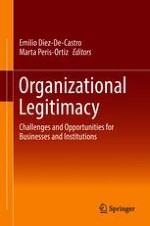2018 | OriginalPaper | Chapter
17. Explanation of the Relation Between Organizational Legitimacy and Firms’ Price
Authors : Raúl Gómez-Martínez, Loarre Andreu, Francisco Díez-Martín
Published in: Organizational Legitimacy
Publisher: Springer International Publishing
Activate our intelligent search to find suitable subject content or patents.
Select sections of text to find matching patents with Artificial Intelligence. powered by
Select sections of text to find additional relevant content using AI-assisted search. powered by
